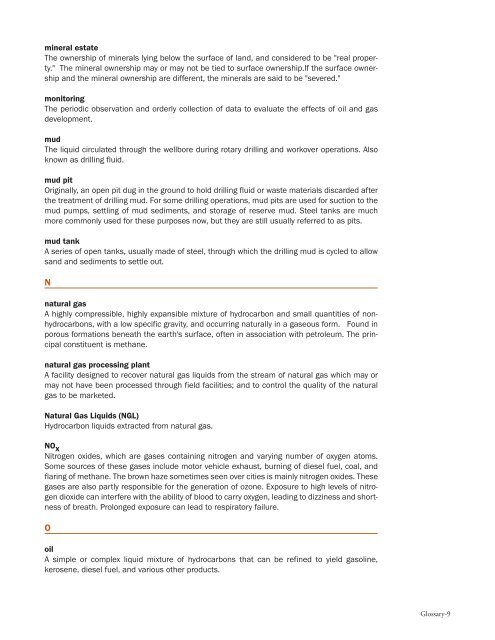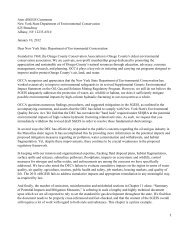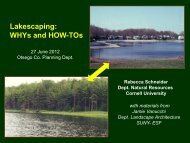Oil and Gas at Your Door? (2005 Edition) - Earthworks
Oil and Gas at Your Door? (2005 Edition) - Earthworks
Oil and Gas at Your Door? (2005 Edition) - Earthworks
Create successful ePaper yourself
Turn your PDF publications into a flip-book with our unique Google optimized e-Paper software.
mineral est<strong>at</strong>e<br />
The ownership of minerals lying below the surface of l<strong>and</strong>, <strong>and</strong> considered to be "real property."<br />
The mineral ownership may or may not be tied to surface ownership.If the surface ownership<br />
<strong>and</strong> the mineral ownership are different, the minerals are said to be "severed."<br />
monitoring<br />
The periodic observ<strong>at</strong>ion <strong>and</strong> orderly collection of d<strong>at</strong>a to evalu<strong>at</strong>e the effects of oil <strong>and</strong> gas<br />
development.<br />
mud<br />
The liquid circul<strong>at</strong>ed through the wellbore during rotary drilling <strong>and</strong> workover oper<strong>at</strong>ions. Also<br />
known as drilling fluid.<br />
mud pit<br />
Originally, an open pit dug in the ground to hold drilling fluid or waste m<strong>at</strong>erials discarded after<br />
the tre<strong>at</strong>ment of drilling mud. For some drilling oper<strong>at</strong>ions, mud pits are used for suction to the<br />
mud pumps, settling of mud sediments, <strong>and</strong> storage of reserve mud. Steel tanks are much<br />
more commonly used for these purposes now, but they are still usually referred to as pits.<br />
mud tank<br />
A series of open tanks, usually made of steel, through which the drilling mud is cycled to allow<br />
s<strong>and</strong> <strong>and</strong> sediments to settle out.<br />
N<br />
n<strong>at</strong>ural gas<br />
A highly compressible, highly expansible mixture of hydrocarbon <strong>and</strong> small quantities of nonhydrocarbons,<br />
with a low specific gravity, <strong>and</strong> occurring n<strong>at</strong>urally in a gaseous form. Found in<br />
porous form<strong>at</strong>ions bene<strong>at</strong>h the earth's surface, often in associ<strong>at</strong>ion with petroleum. The principal<br />
constituent is methane.<br />
n<strong>at</strong>ural gas processing plant<br />
A facility designed to recover n<strong>at</strong>ural gas liquids from the stream of n<strong>at</strong>ural gas which may or<br />
may not have been processed through field facilities; <strong>and</strong> to control the quality of the n<strong>at</strong>ural<br />
gas to be marketed.<br />
N<strong>at</strong>ural <strong>Gas</strong> Liquids (NGL)<br />
Hydrocarbon liquids extracted from n<strong>at</strong>ural gas.<br />
NO x<br />
Nitrogen oxides, which are gases containing nitrogen <strong>and</strong> varying number of oxygen <strong>at</strong>oms.<br />
Some sources of these gases include motor vehicle exhaust, burning of diesel fuel, coal, <strong>and</strong><br />
flaring of methane. The brown haze sometimes seen over cities is mainly nitrogen oxides. These<br />
gases are also partly responsible for the gener<strong>at</strong>ion of ozone. Exposure to high levels of nitrogen<br />
dioxide can interfere with the ability of blood to carry oxygen, leading to dizziness <strong>and</strong> shortness<br />
of bre<strong>at</strong>h. Prolonged exposure can lead to respir<strong>at</strong>ory failure.<br />
O<br />
oil<br />
A simple or complex liquid mixture of hydrocarbons th<strong>at</strong> can be refined to yield gasoline,<br />
kerosene, diesel fuel, <strong>and</strong> various other products.<br />
Glossary-9




